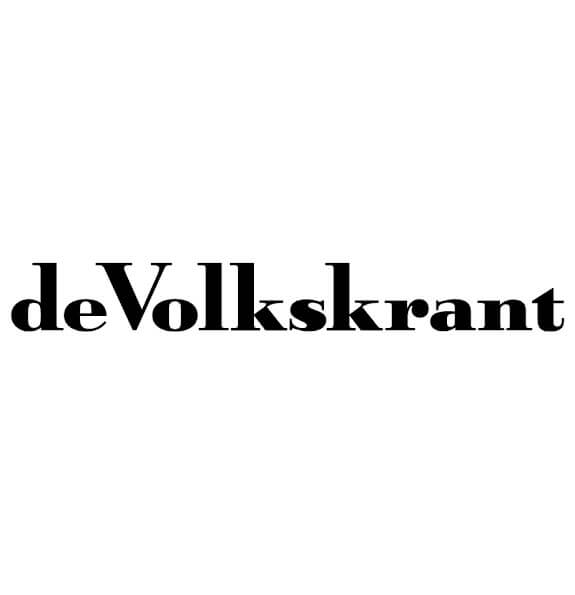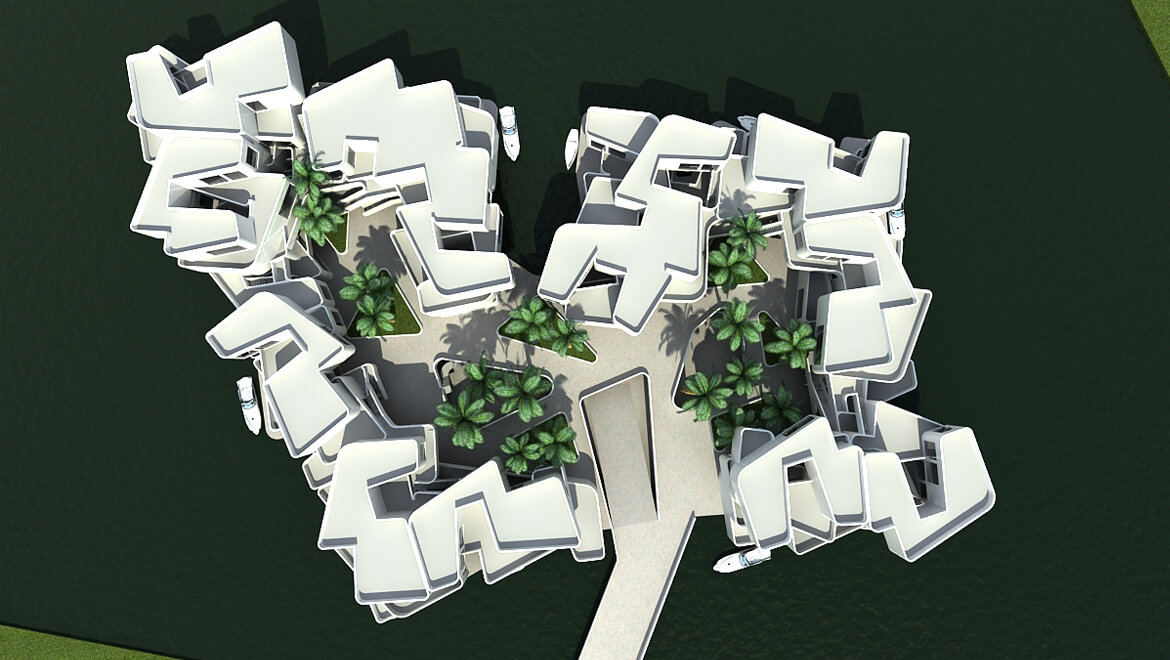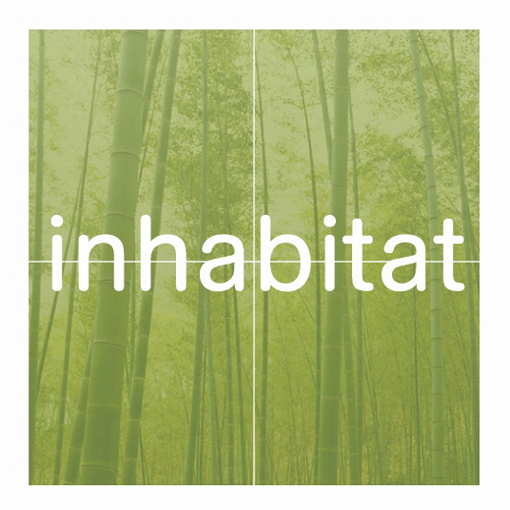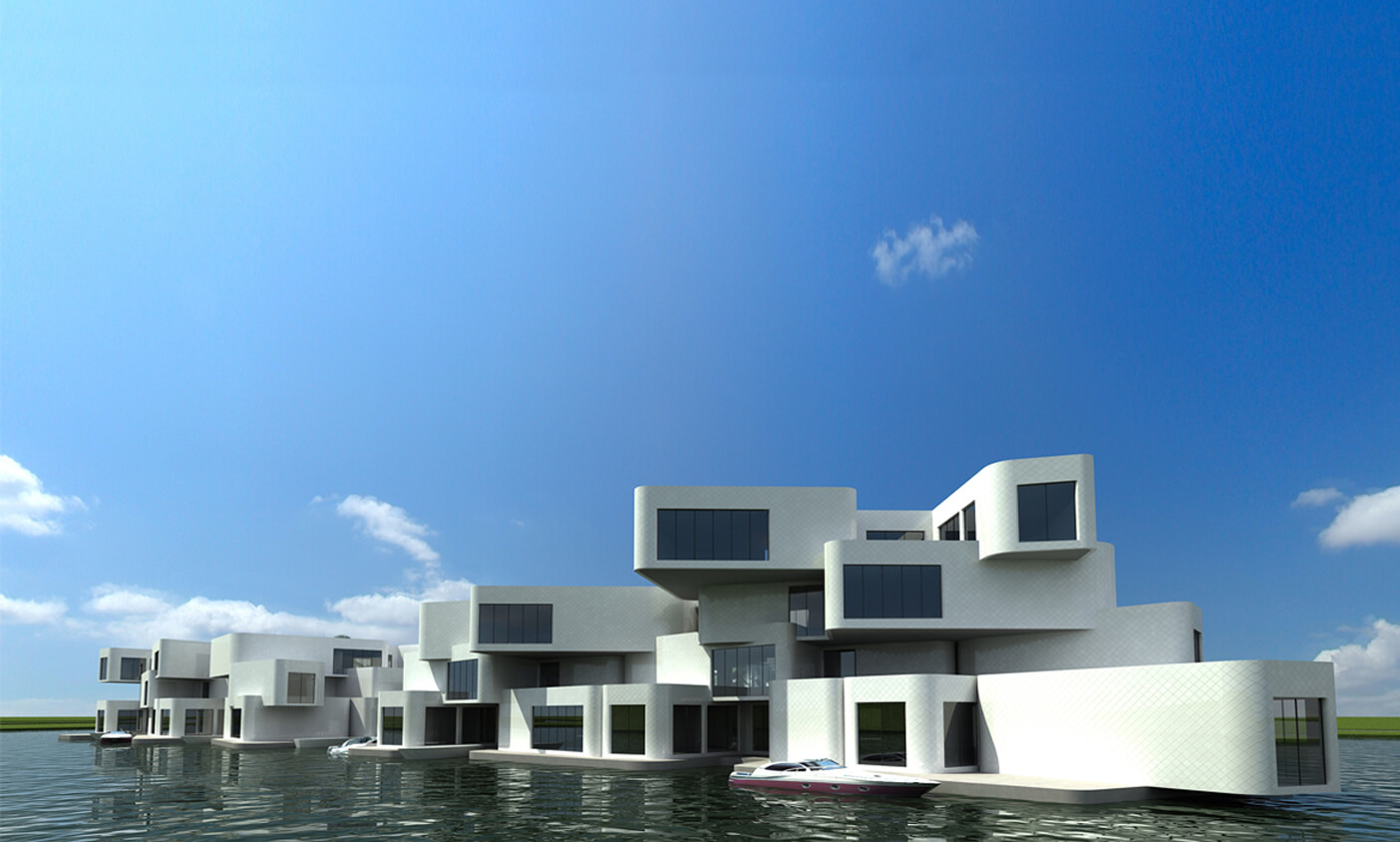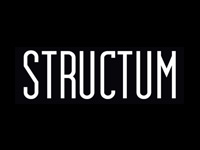Citadel in ABC’s list of bizarre buildings
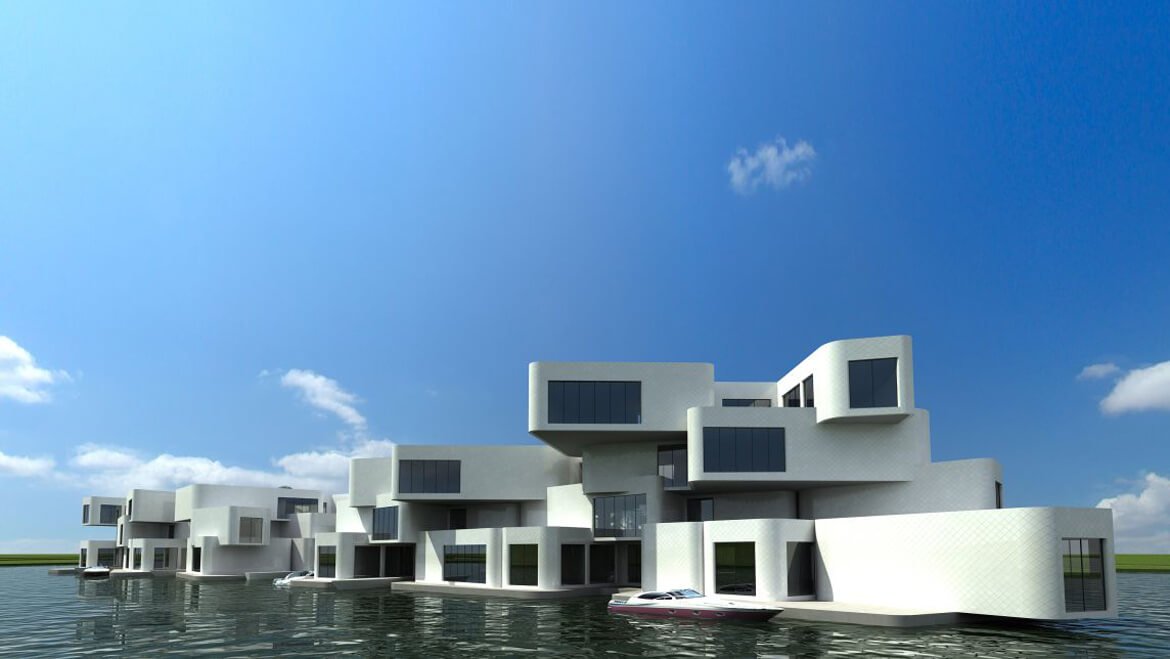
Together with buildings from Gehry and Hundertwasser, Olthuis’ Citadel is mentioned in ‘Worlds most bizarre structures’
The Citadel: Europe’s first floating apartmentcomplex

The Guardian
The Dutch have been fighting the rising and falling tides for centuries, building dikes and pumping water out of areas that are below sea level. Now, rather than fight the water infiltrating their land, the Dutch will use it as part of a new development called ‘New Water’, which will feature the world’s first floating apartment complex, The Citadel. This “water-breaking” new project was designed by Koen Olthuis of Waterstudio in the Netherlands, and will use 25% less energy than a conventional building on land thanks to the use of water cooling techniques.
Olthuis is responsible for a number of floating residences around the world and he thinks that we should stop trying to contain water and learn to live with it. The New Water and the Citadel projects are an attempt to embrace water in the Netherlands, which is almost completely composed of wetlands. The project will be built on a polder, a recessed area below sea level where flood waters settle from heavy rains. There are almost 3500 polders in the Netherlands, and almost all of them are continually pumped dry to keep flood waters from destroying nearby homes and buildings. The New Water Project will purposely allow the polder to flood with water and all the buildings will be perfectly suited to float on top of the rising and falling water.
The Citadel will be the first floating apartment complex, although there are plenty of floating homes out there. Built on top of of a floating foundation of heavy concrete caisson, the Citadel will house 60 luxury apartments, a car park, a floating road to access the complex as well as boat docks. With so many units built into such a small area, the housing complex will achieve a density of 30 units per acre of water, leaving more open water surrounding the structure. Each unit will have its own garden terrace as well as a view of the lake.
A high focus will be placed on energy efficiency inside the Citadel. Greenhouses are placed around the complex, and the water will act as a cooling source as it is pumped through submerged pipes. As the unit is surrounded by water, corrosion and maintenance are important issues to consider. As a result, aluminum will be used for the building facade, due to its long lifespan and ease of maintenance. The individual apartments are built from prefabricated modules. The Citadel will be situated on a shallow body of water, and in the future numerous buildings, complexes and residences will float on the water alongside it.
The Citadel: Europe’s First Floating Apartment Complex

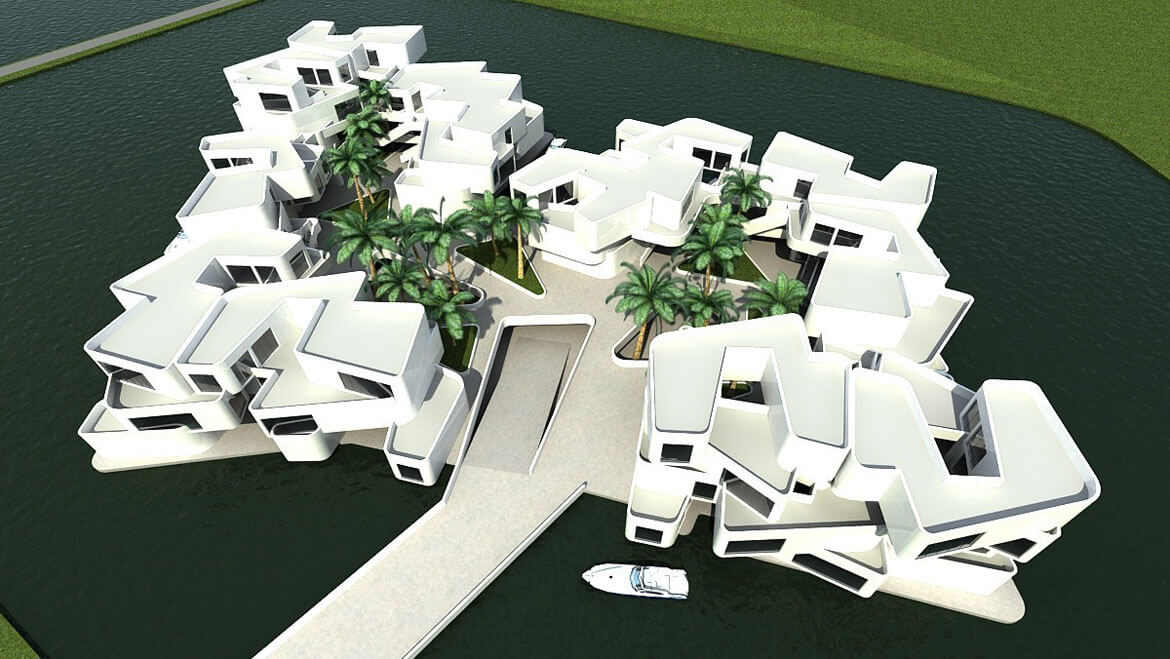
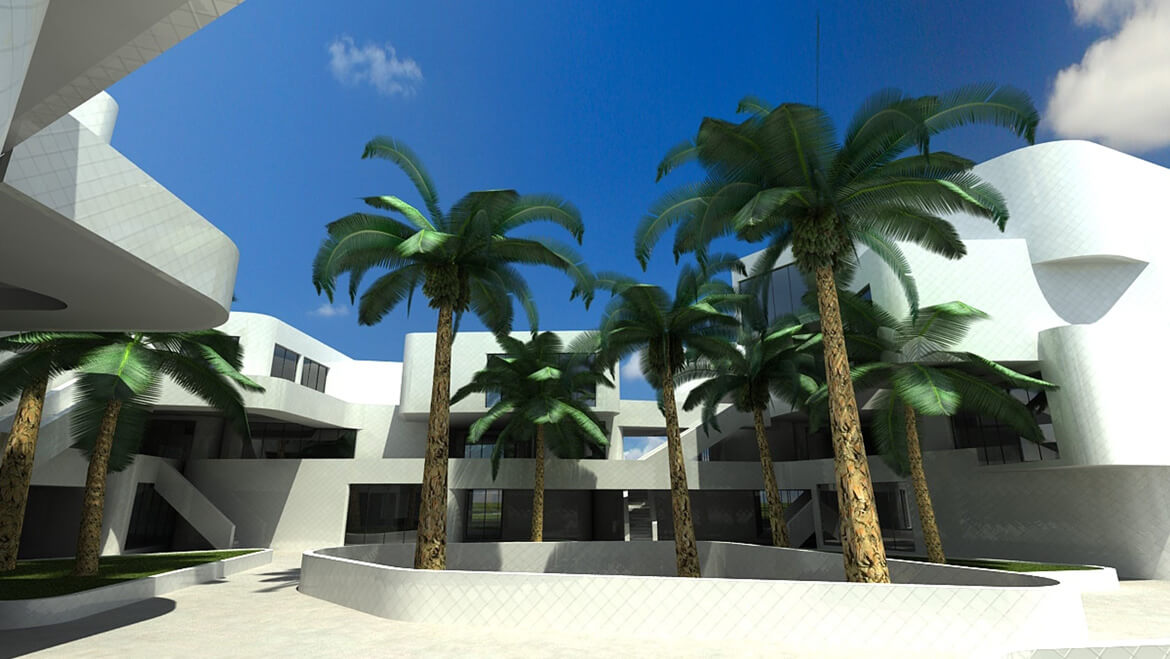
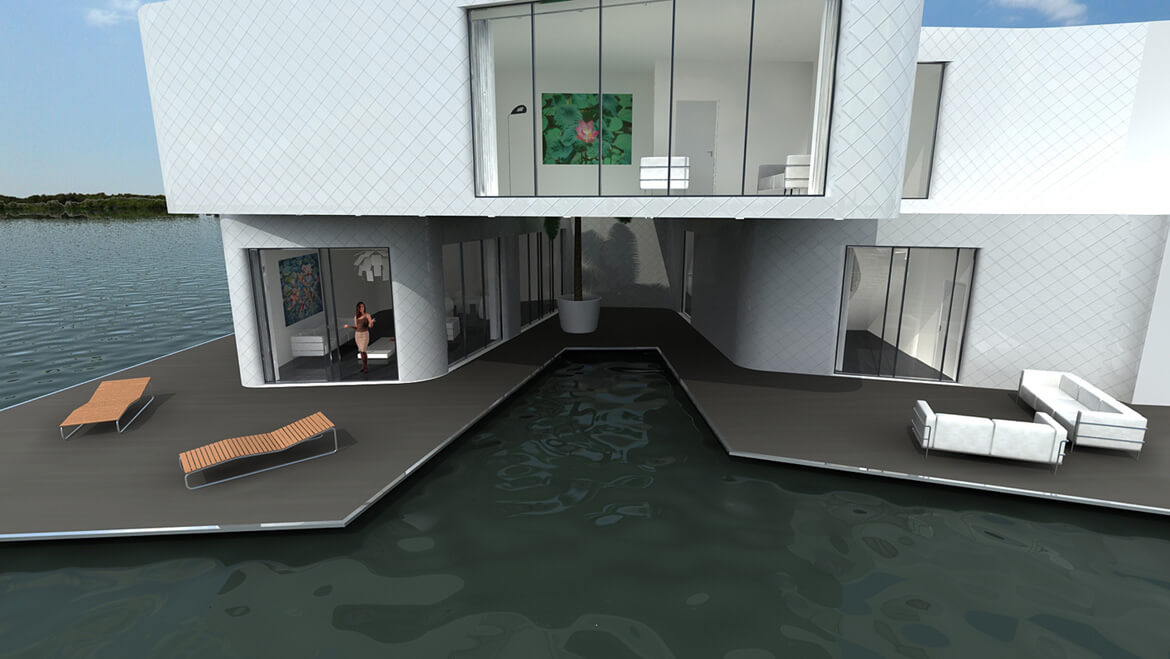
Inhabitat, Bridgette Meinhold
The Dutch have been fighting the rising and falling tides for centuries, building dikes and pumping water out of areas that are below sea level. Now, rather than fight the water infiltrating their land, the Dutch will use it as part of a new development called ‘New Water‘, which will feature the world’s first floating apartment complex, The Citadel. This “water-breaking” new project was designed by Koen Olthuis of Waterstudio in the Netherlands, and will use 25% less energy than a conventional building on land thanks to the use of water cooling techniques.
Olthuis is responsible for a number of floating residences around the world and he thinks that we should stop trying to contain water and learn to live with it. The New Water and the Citadel projects are an attempt to embrace water in the Netherlands, which is almost completely composed of wetlands. The project will be built on a polder, a recessed area below sea level where flood waters settle from heavy rains. There are almost 3500 polders in the Netherlands, and almost all of them are continually pumped dry to keep flood waters from destroying nearby homes and buildings. The New Water Project will purposely allow the polder to flood with water and all the buildings will be perfectly suited to float on top of the rising and falling water.
The Citadel will be the first floating apartment complex, although there are plenty of floating homes out there. Built on top of of a floating foundation of heavy concrete caisson, the Citadel will house 60 luxury apartments, a car park, a floating road to access the complex as well as boat docks. With so many units built into such a small area, the housing complex will achieve a density of 30 units per acre of water, leaving more open water surrounding the structure. Each unit will have its own garden terrace as well as a view of the lake.
A high focus will be placed on energy efficiency inside the Citadel. Greenhouses are placed around the complex, and the water will act as a cooling source as it is pumped through submerged pipes. As the unit is surrounded by water, corrosion and maintenance are important issues to consider. As a result, aluminum will be used for the building facade, due to its long lifespan and ease of maintenance. The individual apartments are built from prefabricated modules. The Citadel will be situated on a shallow body of water, and in the future numerous buildings, complexes and residences will float on the water alongside it.
Waterstudio’s Citadel on Inhabitat


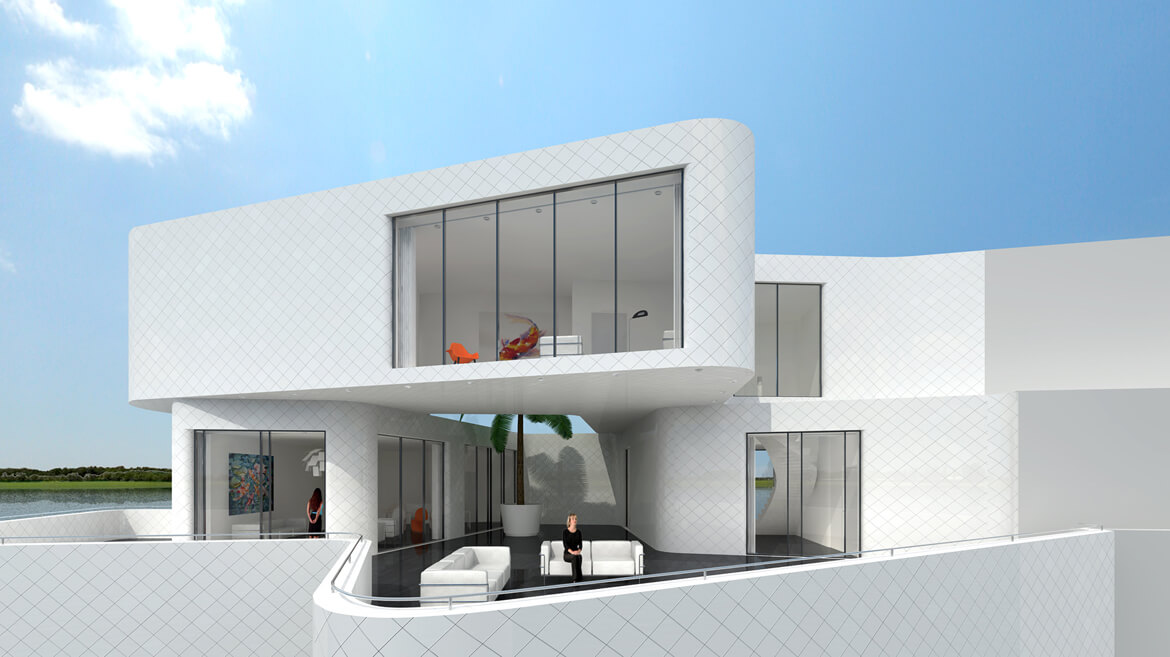
Inhabitat, worlds most influential eco design website has published the Citadel
The Dutch have been fighting the rising and falling tides for centuries, building dikes and pumping water out of areas that are below sea level. Now, rather than fight the water infiltrating their land, the Dutch will use it as part of a new development called ‘New Water‘, which will feature the world’s first floating apartment complex, The Citadel. This “water-breaking” new project was designed by Koen Olthuis of Waterstudio in the Netherlands, and will use 25% less energy than a conventional building on land thanks to the use of water cooling techniques.
Olthuis is responsible for a number of floating residences around the world and he thinks that we should stop trying to contain water and learn to live with it. The New Water and the Citadel projects are an attempt to embrace water in the Netherlands, which is almost completely composed of wetlands. The project will be built on a polder, a recessed area below sea level where flood waters settle from heavy rains. There are almost 3500 polders in the Netherlands, and almost all of them are continually pumped dry to keep flood waters from destroying nearby homes and buildings. The New Water Project will purposely allow the polder to flood with water and all the buildings will be perfectly suited to float on top of the rising and falling water.
The Citadel will be the first floating apartment complex, although there are plenty of floating homes out there. Built on top of of a floating foundation of heavy concrete caisson, the Citadel will house 60 luxury apartments, a car park, a floating road to access the complex as well as boat docks. With so many units built into such a small area, the housing complex will achieve a density of 30 units per acre of water, leaving more open water surrounding the structure. Each unit will have its own garden terrace as well as a view of the lake.
A high focus will be placed on energy efficiency inside the Citadel. Greenhouses are placed around the complex, and the water will act as a cooling source as it is pumped through submerged pipes. As the unit is surrounded by water, corrosion and maintenance are important issues to consider. As a result, aluminum will be used for the building facade, due to its long lifespan and ease of maintenance. The individual apartments are built from prefabricated modules. The Citadel will be situated on a shallow body of water, and in the future numerous buildings, complexes and residences will float on the water alongside it.
Wie Wat Waar Web… Architect!

Constructie CONTOUR zomer 2009
In het Westland, midden in de driehoek Rotterdam, Hoek van Holland en Den Haag wordt gewerkt aan een nieuwe innovatieve woonbeleving. Tussen Naaldwijk en ‘s-Gravenzande ontstaat de eerste woonomgeving in ontpolderd gebied: ‘Het Nieuwe Water’. Door te stoppen met droogpompen van de polder ontstaat een gebied van 80 hectare water. Dit gebied zal er in de toekomst voor zorgen dat er bij hevige regenval genoeg ruimte is om overtollig water te bergen. In ‘Het Nieuwe Water’ worden ruim 1.200 woningen gerealiseerd, waarvan 600 drijvend. Het eerste project in dit gebied is de Citadel.
VORMENTAAL
Bij het ontwerp van de Citadel ligt het ambitieniveau hoog. Bij drijvend wonen denkt men vaak aan bruin houten woonarken. Met het ontwerp van de Citadel willen wordt duidelijk dat er veel meer mogelijk is. De Citadel kenmerkt zich door haar vloeiende vormentaal, moderne materialisering en imposante verschijningsvorm. Voor de opbouw van het gebouw is gekozen voor een bijzonder, architectonisch element. Door het element op unieke wijze te stapelen en te schakelen, ontstaat een ogenschijnlijk willekeurige structuur, met een duidelijke samenhang en identiteit. De keuze voor deze methode heeft tevens tot gevolg dat woningen de beschikking hebben over grote terrassen en daktuinen.
MET DE BOOT
Noemenswaardig is vooral de architectonische beleving op de route van de parkeergarage tot in je eigen
woning. Middels een lift die je tot in je eigen woning brengt, betreed je de ruime woning. Een tweede manier om het gebouw te betreden is met de boot. Je vaart met je boot naar je eigen woning en legt aan. De hogergelegen woningen hebben een collectieve haven.
ENERGIE
Naast toepassingen van duurzame materialen met lange levensduur, worden voor Het Nieuwe Water samenwerkingen aangegaan met de glastuinbouwers in de omgeving. Resultaat hiervan is dat de Citadel energie kan gebruiken die direct door de eigen omgeving wordt opgewekt.
New Water in Cobouw
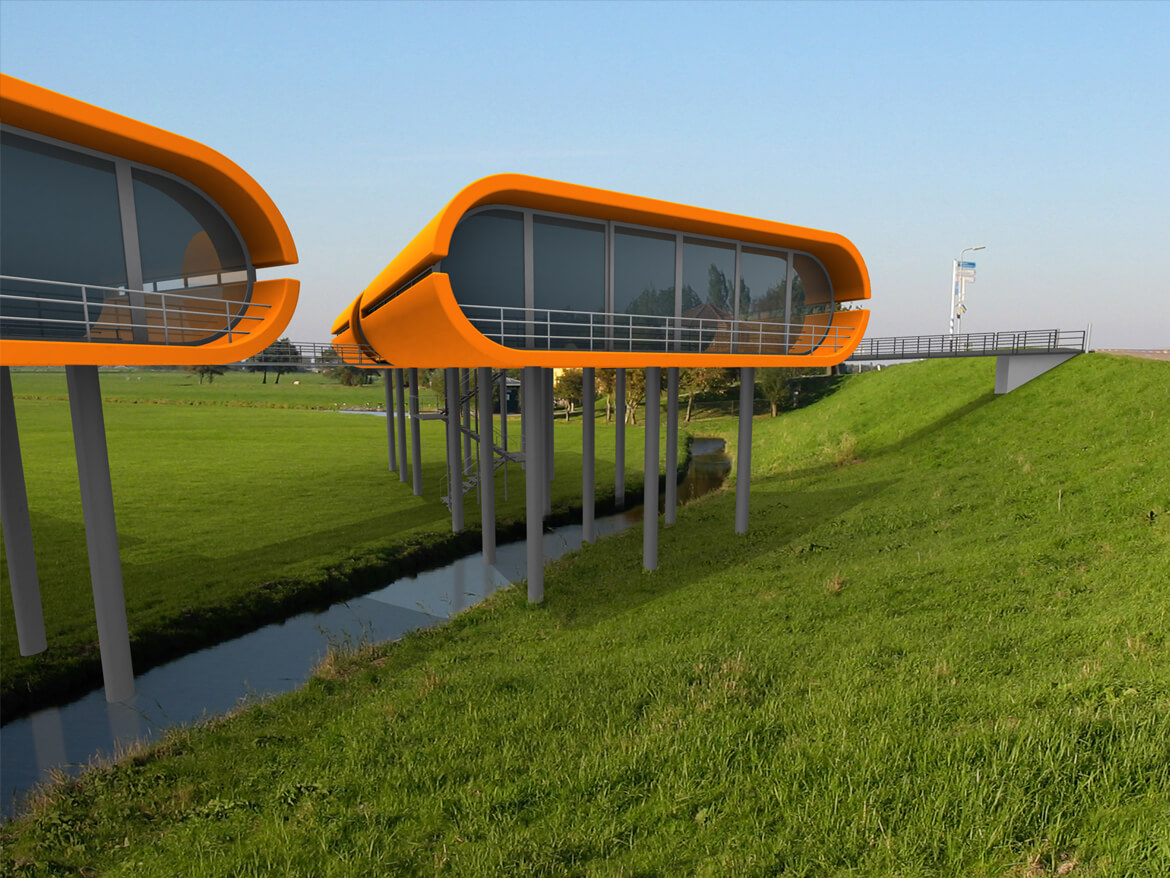

An article in Cobouw about the Citadel and the New Water in Naaldwijk
Waterwonen in Poelpolder zonder kopje onder te gaan
Written by Cobouw, Edo Beerda
Waterwonen in Poelpolder zonder kopje onder te gaan


Cobouw, Edo Beerda
De voormalige Poelpolder tussen Naaldwijk en ‘s-Gravenzande verandert tussen 2010 en 2017 in Nederlands eerste woonlocatie op het water in ontpolderd gebied. Met drijvende appartementencomplexen, wegen en eilanden.
Volgend jaar al moet de bouw van start gaan van een spectaculair drijvend appartementeneiland met zestig wooneenheden. Illustraties tonen een complex
(‘Citadel’) dat eerder thuis lijkt te horen in Dubai dan in het Westland. Op het grillig vormgegeven eiland van 60 bij 100 meter staan luxueuze gestapelde
villa’s – drie hoog – met palmbomen ertussen en aan alle kanten aanlegplaatsen voor bootjes. De drijvende toegangsweg duikt ondergronds naar een parkeergarage met 150 plaatsen, recht onder de huizen. ”Het is simpel met bestaande technieken te realiseren”, vertelt ontwerper Koen Olthuis (Waterstudio.NL).
”Je bouwt in een droogdok met behulp van een bekisting en een tijdelijke stabilisatiefundering een betonnen bak. Die wordt ongeveer 3 meter diep. De wet
van Archimedes vertelt wat je erop kunt bouwen, zonder kopje onder te gaan wanneer het gebied onder water wordt gezet.” Bouwen op drijvende constructies
is niet nieuw. In het naburige Naaldwijk realiseerde Dura Vermeer vijf jaar geleden al zijn roemruchte drijvende kas – op een eps drijflichaam en een met
staalvezel gewapende betonvloer. Dat de techniek wordt gebruikt om aantrekkelijke woningbouw te realiseren midden in een enorme waterberging is wel
een noviteit. Waterstudio.NL bedacht in opdracht van Ontwikkelingsmaatschappij het Nieuwe Westland (ONW) en in samenwerking met ingenieursbureau Van der Waal & Partners een stedenbouwkundig plan met acht ‘waterkamers’ met ieder een eigen karakter, dichtheid en waterbeleving. Als de eerste kamer, met de Citadel, af is, wordt deze vol gezet met water. Het werk aan de volgende waterkamer kan daarna beginnen. Uiteindelijk komt 27 van de 80 hectare onder water te staan.
Goed voor watersporters, vogels en vissen, maar ook voor uiteenlopende bouwvormen.
Waterkamer
Het totaalplan Het Nieuwe Water bevat kamers met paalwoningen, met terpwoningen en met drijvende privé-eilandjes (400, 600 en 1000 vierkante meter). Maar het heeft ook een waterkamer met sociale woningen rond een paar nieuwe haventjes. Olthuis: ”Het gaat om een wijkje met een Venetiaanse schaal en dichtheid.” De waterkamers worden een voor een in het droge gebouwd en vervolgens onder water gezet. Ontwikkelingsmaatschappij het Nieuwe Westland
(ONW) – een pps-constructie tussen Gemeente Westland, provincie Zuid-Holland Hoogheemraadschap van Delfland en de private Ontwikkelings- en
Participatiebedrijf Publieke sector BV – wil in het gebied 1200 woningen realiseren. Er wordt ook zo’n 1 miljoen kuub aarde afgegraven. ONW slaat met het
plan ‘Het Nieuwe Water’ een paar vliegen in één klap. De Poelpolder ligt op een van de laagste punten van het Westland en heeft in het verleden veel problemen
gehad met wateroverlast. Extra waterbergingscapaciteit is daarom dringend noodzakelijk in het gebied. Het oog viel op de Poelpolder omdat dit
glastuinbouwgebied verouderd is, deels doordat bedrijven er geen uitbreidingsmogelijkheden hebben. Uitkopen van de glastuinders is kostbaar, maar
door in de plaats ervan zowel woningbouw als een waterberging te realiseren wordt het betaalbaar. Omdat de belangen van de betrokken partijen samenvallen,
worden in Het Nieuwe Water bovendien makkelijk spijkers met koppen geslagen als het gaat om vergunningen, regelgeving en uitvoeringsbesluiten. ONW heeft
inmiddels 95 procent van de grond in handen. Daarvan komt een derde onder gemiddeld 1,40 meter water te staan – boezempeil. Op plaatsen waar drijvende
woongebouwen komen wordt het water tot 4 meter diep. Daarvan komt een derde onder gemiddeld 1,40 meter water te staan – boezempeil. Door het wateroppervlak op boezemniveau te brengen ontstaat een continu berging voor het boezemsysteem, dat daardoor robuuster wordt. Door een toelaatbare peilstijging van 35 centimeter kan totaal 75.000 kubieke meter water geborgen worden. Bij calamiteiten dat niveau nog eens met 30 centimeter stijgen, waardoor een extra piekberging ontstaat van 75.000 kubieke meter. Bij calamiteiten kan het waterpeil nog eens met 30 centimeter stijgen, waardoor een extra piekberging
ontstaat van 75.000 kubieke meter. ”Bij het Hoogheemraadschap Delfland waren ze direct enthousiast, want zij moeten uiterlijk 2010 hun wateropgave gerealiseerd hebben”, vertelt planmanager Marleen van Giesen (ONW). ”Opofferen van een polder betekent bovendien dat ze een gemaal kunnen uitzetten.”
Ecologische zone
De randen van het gebied zijn groen en blijven dat ook. Ze moeten fungeren als ecologische zone. Olthuis: ”Je zou het hele gebied kunnen zien als een schilderij. We laten de lijst intact, maar leggen er een nieuw schilderij in.’ Fiets- en wandelpalen door de groene randen verbinden het gebied met het Staelduinse Bos en de Nieuwe Waterweg. In de buitenranden komt ook de hoofdinfrastructuur. Water, riolering, gas en elektra van de drijvende woningen worden hierop met behulp van flexibele leidingen op aangehaakt. Ingenieursbureau Van der Waal & Partners onderzoekt ook een mogelijke energiekoppeling met omliggende tuinbouwkassen. ”De glastuinbouw heeft veel overtollige warmte die we kunnen gebruiken voor verwarming van de woningen. En we bekijken het gebruik
van geothermie”, vertelt Paul van Zundert (projectleider Van der Waal & Partners). ”Voorwaarde is natuurlijk dat we uit de kosten komen van het slaan
van de benodigde bronnen.” Die bedragen ongeveer 10 miljoen euro.
Voorbeeld
De grootschalige ontpoldering in Westland is volgens Olthuis een lichtend voorbeeld voor de 3500 polders die Nederland nog heeft. ”Het is onvermijdelijk
dat we een aantal daarvan gaan inrichten als waterbuffers. Wij creëren hier een proeftuin waarin we aantonen dat dit niet hoeft te betekenen dat zo’n gebied
onbruikbaar wordt. Waterwonen is geëvolueerd van IJburg – huizen met steigertjes erbij – tot compleet ontworpen waterwijken die profiteren van alle technieken die inmiddels zijn bedacht. En daarvoor hebben we ook nog eens een gezonde financiële onderbouwing.”
Presentation first floating apartmentcomplex ‘Citadel’ in Westland

Waterstudio has showed his first design of the first floating apartmentcomplex to the public in Westland. More information about the Citadel can be found on www.citadelhetnieuwewater.nl.
Zaluma yra gerai, bet vandens zydryne-dar geriau
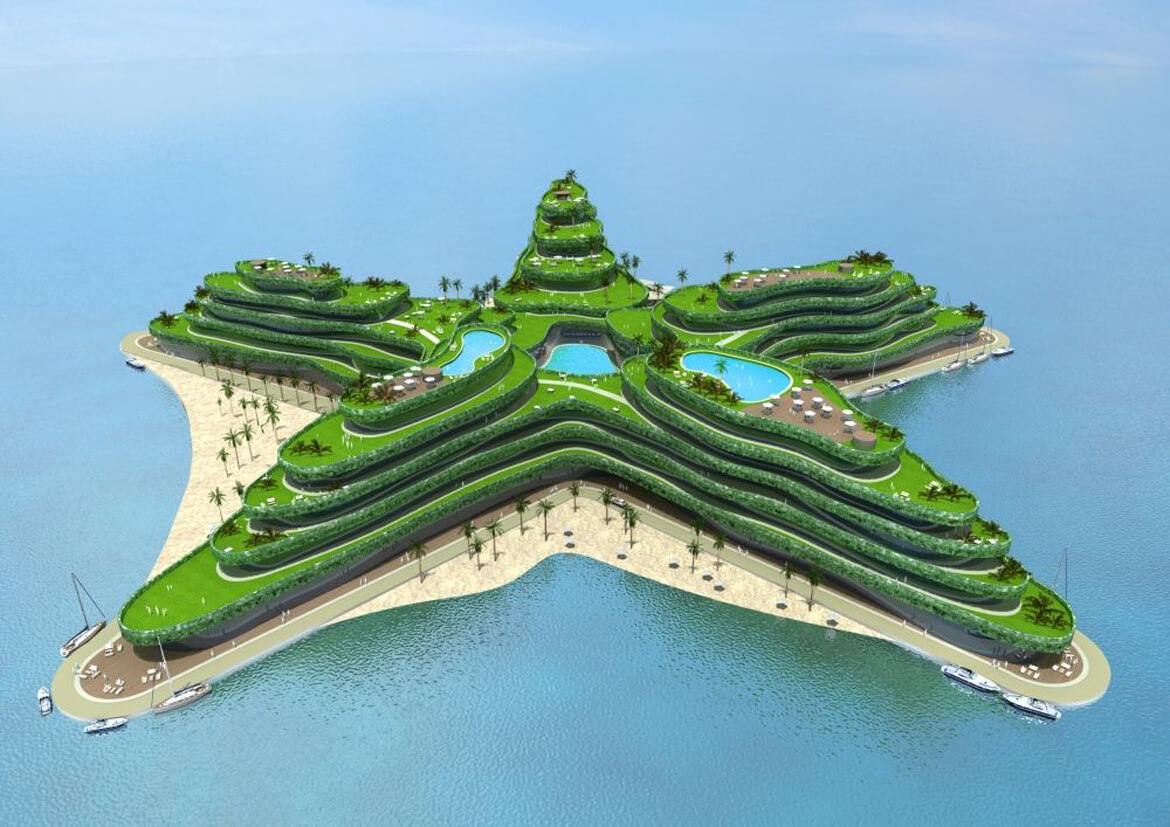


June 2014
Structum, Jurgita Siliuniene
Architektūriniai sprendimai ant vandens nėra įprasti ir kasdieniški, tad kokios klientų ir kolegų reakcijos sulaukia jūsų projektai?
Gyvename laikais, kai technologiškai beveik viskas yra įmanoma. Mes naudojame įprastas ir laiko patikrintas technologijas, kurios jau seniai taikomos projektuojant plūduriuojančias naftos platformas ar didelius kruizinius laivus.
Didžiausias iššūkis, su kuriuo susiduriame šiandien, – tai žmonių, tiek klientų, tiek valstybinių institucijų, mąstymas ir supratimas apie gyvenimą ant vandens. Manau, kad ateityje plaukiojantys pastatai ar net plaukiojantys miestai bus kasdienybė ir nedaug skirsis nuo įprastų miestų, prie kokių esame įpratę šiandien.
Žinoma, taip pat svarbu užtikrinti, kad plaukiojantys pastatai turėtų tą patį komforto lygį ir kainuotų tiek pat, kaip ir pastatai ant žemės. Vienintelis tokių architektūrinių sprendimų skirtumas – plūduriuojantis pagrindas, sudarytas iš plūduriuojančių platformų junginio, kurį prireikus galima praplėsti, prijungiant papildomas platformas. Tai mes vadiname „City apps“ – plūduriuojančių miestų komponentais. Tai gali būti papildomas stadionas, golfo aikštynas, naujas namų kvartalas arba nauji keliai.
Naudojant „City apps“ plaukiojantį miestą galima transformuoti ir pritaikyti pagal gyventojų poreikius. Tokie architektūriniai sprendimai labai tinka prie vandens įsikūrusioms bendruomenėms, yra mėgstami salynų kurortuose, be to, tai puiki galimybė tankiai apgyvendintoms teritorijoms, pavyzdžiui, Kinijoje.
Kokia buvo jūsų idėjos įgyvendinimo pradžia?
Jaunystėje mane labai žavėjo Olandijos kraštovaizdis, šalies vandens ir žemės struktūra. Tuo metu gyvenimas ant vandens buvo įmanomas tik specialiai tam pritaikytuose laivuose. Taigi siekdamas įgyvendinti savo idėją – apgyvendinti žmones ant vandens – 2002 m. pabaigoje įkūriau pirmąją pasaulyje miestų ant vandens architektūros įmonę „Waterstudio.NL“.
Esu šios rinkos pradininkas, tad teko įdėti nemažai pastangų, norint pakeisti plačiosios visuomenės suvokimą apie gyvenimą ant vandens.
Ar gyvenimas ant vandens turi tradicijų?
Olandijoje žmonės ant vandens gyvena jau daugiau nei 100 metų – čia yra įprastų laivinių namų, kurie plaukioja upėmis, miestų kanalais.
Kuo skiriasi architektūra ant žemės ir ant vandens?
Vienintelis dalykas, kuris skiriasi nuo sausumos, – plūduriuojantis pagrindas. Taip pat, jei namai statomi ant jūros paviršiaus, naudojamos sūriam vandeniui atsparios medžiagos.
Kiek ir kokių projektų esate įgyvendinęs?
Įgyvendiname savo sprendimus visame pasaulyje – Maldyvuose, JAV, Indijoje. Nyderlanduose jau pastatėme daugiau nei šimtą plūduriuojančių namų ir pastatų. Šiuo metu įgyvendiname ypatingą projektą – nedidelio biudžeto būsto sprendinius lūšnynų bendruomenėms.
Milijonai žmonių gyvena lūšnynuose prie vandens, jiems kyla nuolatinė potvynių ir cunamių grėsmė, tad mūsų tikslas, naudojant plaukiojančių namų architektūrinius sprendimus, padėti žmonėms susikurti tokį būstą, kuris nebūtų suniokojamas gamtos stichijų.
Tačiau ar saugus toks būstas ant vandens, ypač turint omenyje , kad jūros lygis kyla?
Taip, kai kyla jūros lygis, saugiausia vieta ir yra ant vandens.
Kokią įtaką miestai ant vandens turės architektūros tradicijoms?
Tai niekaip nepakeis pačios architektūros, tik pakeis mūsų mąstymą apie miestus, gyvenamąjį ar pramoninį būstą.
Šiuolaikiniai dizaineriai yra klimato kaitos karta, tad turėtų pradėti mąstyti apie dinamiškas, o ne statiškas statybų konstrukcijas.
Ar ši architektūra yra nekenksminga gamtai?
Mums labai svarbus ekologinis tvarumas. Ant vandens galime išgauti tvarią saulės energiją, be to, nenaudojamus namus lengva perkelti į kitą vietą. Palyginkite – ant žemės stovintys nenaudojami, griūvantys pastatai metų metus niekieno neprižiūrimi darko kraštovaizdį ar miesto architektūrą.
Vanduo mums suteikia unikalią galimybę kurti tvarias technologijas, taigi žaluma yra gerai, bet vandens žydrynė – dar geriau!
